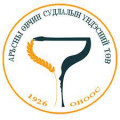Epidemiology of Dermatophyte Infections in Mongolia. A Five-Year Retrospective Study
Судалгааны тайлбар: Abstract
Objectives: Dermatophyte infections have been considered to be a major public health
problem in many parts of the world. We investigated the epidemiology of fungal skin
infections through a retrospective analysis of patient’s medical records between 2014
and 2019.
Methods: A total of 24,484 patients clinically suspected of cutaneous fungal infections
were examined. Skin scales, plucked hairs, nail clippings and sub-ungual debris were
examined by direct microscopy and culture. Dermatophyte species were identified atthe
species level by a combination of morphological and physiological criteria.
Results: 13,386 (51.0%) of 24,484 participants were male and 12,843 (48.9%) were
females. The male to female ratio was 1:1,1. The mean (±SD) and the median age of the
participants were 23.5 (±0.12). Direct microscopy confirmed a combinated rate of 28.5%
(6,973/24,484 cases). Among the 1747 mycological suspects cases, 560 (32.1%) patients
had dermatophyte and yeast infections based on culture. Tinea corporis 2,420 (9.5%)
was the most prevalent type of dermatophytosis followed by tinea faciei 1,338 (5.5%),
tinea capitis 1,187 (4.9%), and tinea pedis 833 (3.4%). The percentage of positive cultures
most frequent isolated was Trichophyton 19 (1.1%), Microsporum canis 7(0.4%), Candida
albicans 518 (29.6%), Candida krusei 11(0.6%).
Keywords: Mongolia, Epidemiology, Dermatophyte, Yeast, Skin Infections
Судалгааны мэдээлэл
pdf- Дундаж үнэлгээ
- Үзсэн тоо
- 1.3K
- Татсан тоо
- 404
- Файлын хэмжээ
- 283.20 KB
- Оруулсан огноо
- 2023.04.26
- Судалгаа хийгдсэн он
- 2021 он
- Судалгааны арга зүй
- Retrospective analysis
- Судалгааны салбар
- Эрүүл мэндийн шинжлэх ухаан
- Санхүүжилтийн эх үүсвэр
- Гадаад, дотоодын хөрөнгө оруулалт
- Гүйцэтгэгч байгууллага
- Арьсны өвчин Судлалын Үндэсний Төв
- Захиалагч байгууллага
-
 Арьсны өвчин судлалын үндэсний төв lkhagvasurenmd@gmail.com 88091821 Арьсны өвчин судлалын үндэсний төв ....
Арьсны өвчин судлалын үндэсний төв lkhagvasurenmd@gmail.com 88091821 Арьсны өвчин судлалын үндэсний төв .... - Судалгааны баг
Enkhtur Yadamsuren1 *, Uranchimeg Tseden-Ish1,2, Bilguuntsooj Soyolbaatar1 , Enkhjargal Jamyansuren2 , Sukhbold Byambaa2 , Oyunchimeg Manibadraa2 and Battogtokh Chimeddorj3 1 Department of Dermatology, Mongolian National University of Medical Sciences, Ulaanbaatar, Mongolia 2 Mycological Laboratory, The National Dermatology Center of Mongolia, Ulaanbaatar, Mongolia 3 Department of Microbiology, Mongolian National University of Medical Sciences, Ulaanbaatar, Mongolia